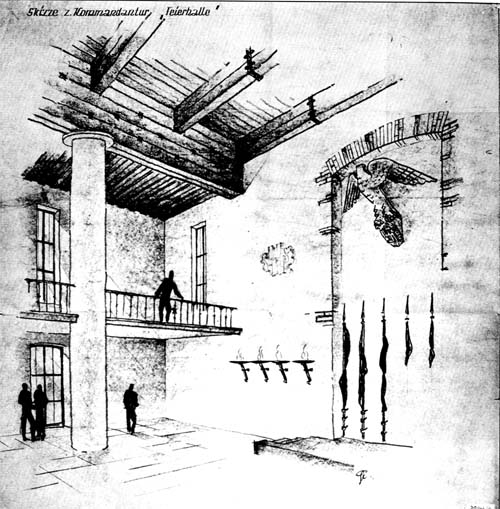|
|
 |
 |
AUSCHWITZ:
Technique
and Operation
of
the Gas Chambers © | |
|
| |
 |
Back |
 |
Contents |
Page 517 |
 |
Home
Page |
Forward |
 |
| |
| CHAPTER ONE |
| |
THE ABORTED FUTURE OF
THE STAMMLAGER
WITHOUT
EXTERMINATION |
| |
Attempt to investigate the future of
KL Auschwitz (the Stammlager)
as it was being planned in
1941 and 1942 |
| |
The protective custody camp, later concentration camp
at Oswiecim (Auschwitz) was to be part of the development of a
German settlement or colony [Siedlung] in this region that the Nazis
considered to be too Polish. Before the order to exterminate the
Jews arrived and radically changed the face of the camp, the
Bauleitung was asked to draw up development plans which were
intended to he an “SS model” for the Eastern Marches.
This
project was considered so important that architects came from Berlin
to work on the spot. The style, quality and power of the buildings
envisaged are perfectly reflected in the artist's impression of the
“Ceremonial Hall” of the New Headquarters [Kommandantur] at
Auschwitz [Document 1]. The grandiose structures of the SS
builders were intended to last a thousand years.
The
development plan for the town of Auschwitz had three main
components: |
| |
| 1. |
Extension and reorganization of
the concentration camp, a pool of labor, based on the old Polish
barracks and the creation of a monumental SS complex with adjoining
family quarters to the north. An industrial zone was to flank the
camp on the west, [Document 3 is the overall plan of the
project. Documents 1 and 2 are artists' impressions of the
interior of the New Garrison Headquarters and Documents 4 to to
10 are elevations and plan drawings of the SS accommodation in
the northern part of the garrison area]. |
| |
|
| 2. |
Reorganization of the town of
Auschwitz and of its center, designed as a military and industrial
city. To the east is the vital link between the city and the outside
world, the railway station. The concentration camp, is located in
the Zasole district, between the station, the river Sola and the old
town, but for the SS it was not to belong to the city of Auschwitz.
being territorially, administratively and legally distinct from it.
It was simply to be a “highly concentrated” working class suburb.
There were to be three German residential districts centered on the
old town: Blonie (to the cast), Dwory (to the west) and Osiedle (to
the south). The number of bridges across the Sola (to the east) and
the Vistula (to the north) was to be eight times the prewar figure
[Document 11, development plan for the Auschwitz region:
Document 12, development plan for the town of Auschwitz; Document
13, Nazi Party community center, its precise location not known,
but somehow here near the IG Farbenindustrie zone; Document
14, plan of the forum of the new city, eastern district;
Document 15, model of the proposed redevelopment of the old
town; Document 16, partial view of a model of a housing estate,
probably in the southern district of the city).
Paradoxically enough, the development plans for the town of
Auschwitz produced in September-October 1942 were considered
“secret” whereas the project for a crematorium in January 1942 was
not. The January drawings, however, concerned a perfectly normal
cremation installation whose existence could be revealed, though
when its conversion to a criminal instrument was envisaged the
situation changed. On the other hand, the development plans, and
hence the drawings, for the town of Auschwitz were directly
connected with the German war effort and the presence of a vital
component: a synthetic fuel plant. From the standpoint of the
conflict in progress, knowledge by the Allies of German industrial
projects in the Auschwitz area would have been more valuable than
the plans of buildings that resembled bakeries. |
| |
|
| 3. |
Installation at Monowitz of a
huge industrial complex by IG Farbenindustrie, producing sythetic
fuel (methanol) and synthetic rubber (the Buna plant). This
industrial center was located on the Silesian coal basin and used
coal as its raw material. The engineers and technicians were to be
Germans or nationals of other Axis countries, semi-skilled workers
would be supplied by compulsory labor schemes in the occupied
countries and unskilled workers would he prisoners of war and
internees from the camp
Other industrial zones were to
be established around the giant IG Farben complex: two south of the
camp: one northwest of the station and one north of Dwory. The
industrial strip to the south of the camp and the Monowitz complex
were the only ones actually built. |
|
| |
 |
|
| |
Document 1
[PMO neg. no. 20944/2] |
|
| |
|
|
| |
Skizze z. Kommandantur
“Feierhalle”
Sketch for the "Ceremonial Hall" of the garrison
headquarters
The sketch is dated 1942, but the artist’s
initials are not known. The sketch shows the interior of the hall in
the main building of the new headquarters, but it cannot be located
exactly because we have no detailed drawing of BW/Worksite 173. of
which Documents 1 and 2 are the only known illustrations of
the interior arrangements. |
| |
| |
AUSCHWITZ:
Technique
and operation
of the gas chambers
Jean-Claude Pressac
© 1989, The
Beate Klarsfeld Foundation |
 |
Back |
Page 517 |
Forward |
 |
|

